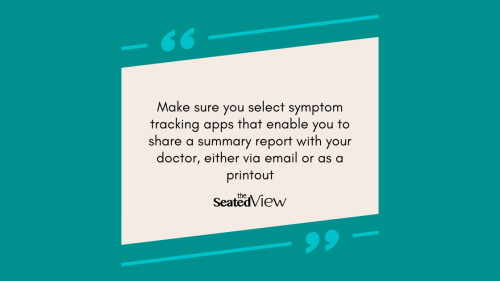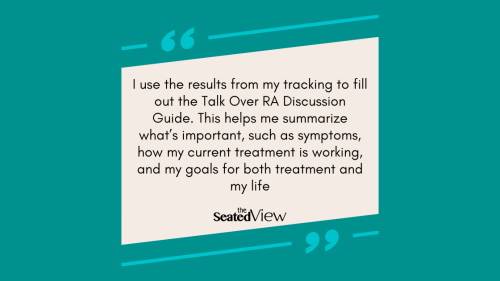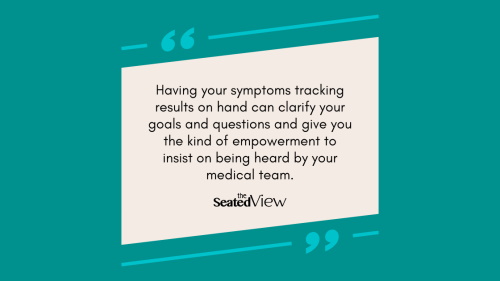Talk Over RA: How to Track Rheumatoid Arthritis Symptoms and Monitor Treatment Progress

“How have you been since your last appointment?”
If you’re anything like me, this question from your rheumatologist instantly causes your mind to go blank. When I don’t have a clear picture of my health, it gets in the way when I try to Talk Over RA with my medical team and affects my rheumatoid arthritis (RA) treatment. To have an answer to that question, I need something better than my memory. That’s when symptom tracking enters the picture. Keeping an eye on your symptoms and your progress can give you the clarity you need to work with your doctor and maximize your treatment so you can get back to your life. In this post, I’ll look at the benefits of tracking to assess the progress of your treatment, share different tracking systems, and show you how to use the results to make the most of your RA treatment.

The benefits of tracking your RA symptoms
RA many areas of your life. Over 90% of people with RA have difficulties with daily activities and symptoms like morning stiffness, fatigue and pain affect 80% of this community. Combine them all together, add brain fog, and it can all feel like a muddled mess, making it difficult to get your doctor the kind of details they need to recommend the best treatment for you. Here’s another RA wrinkle that affects your report to your doctor: this condition is unpredictable. Often, worsening symptoms sneak in so gradually you may not notice how bad things have gotten until they’re very bad indeed. It’s a little like that story of boiling frogs (if you’ll forgive the gruesome analogy). If you pop a frog into boiling water, the story goes, it’ll jump right out. But if you put it into cold water and very gradually increase the heat, it will stay in the water. In this case, RA is the boiling water and… well, we are the frogs.

Watch my Facebook panel discussion about the benefits of tracking your symptoms and how three RA advocates use the results:
Tracking your symptoms serves several purposes. It circumvents possible memory glitches and shows a true picture of both your symptoms and the effectiveness of your current treatment. Having this data can also be empowering. When you have a chronic illness, it’s important to put yourself in the driver’s seat when speaking to your medical team. A doctor’s appointment can be very stressful and intense, making it difficult to push through our cultural conditioning that says the doctor is in charge.
Having your symptom tracking results at hand can clarify your treatment goals and questions and give you the kind of empowerment to insist on being heard by your medical team. More on how to use your tracking data to communicate with your doctor below.

How to track your symptoms
There are two main ways to tracking symptoms, analog and digital. I grew up with autoimmune arthritis in the days before both effective treatment and the Internet, so I tend to rely on a notebook and a pen.
There are many ways to track your symptoms using a notebook and pen, but I use a very simple one. Every day, I give a letter grade to three aspects of my health: physical, emotional, and fatigue. I then write this letter grade, one atop another, into a monthly spread in my planner using different coloured markers. The colours make them pop a little more, which means I can easily get an overview of how I’ve been doing. It takes just a few minutes every morning and since I usually start the day with my planner anyway, it’s integrated into my regular habits.
If you want to go digital, you can use a spreadsheet, creating a chart that shows how you were feeling on each day. You can also use graph paper for a chart like this. Just like using a notebook or planner, this is something that can be done pretty quickly first thing in your day.

That said, most people probably use symptom tracker apps installed on their smart phone. There are a lot of options for tracking apps and you may want to try a few well-rated options to see which you like best. Make sure you select symptom tracking apps that enable you to share a summary report with your doctor, either via email or as a printout. You may also want to consider apps that track both your symptoms (for instance, pain) and your use of medication, as this might help you create a pattern of what works and what doesn’t.

How to use your symptom tracking data
I like to prepare for my appointments as I would an important meeting. I use the results from my tracking to fill out the Instead of being frustrated the night before your appointment, you can create a more concise summary. This can be an important communication tool to help your doctor understand how RA is affecting your life. As well, this report becomes a vital part of your records, showing how you responded to different meds or stressors in your life.

Regardless of the method you use for tracking your symptoms, you will have an excellent reference document that you can use to get an accurate view of your health. When you sit down to fill out the Talk Over RA Discussion Guide, you have specific information that create the foundation for updating your goals and approach to treatment. Make two copies of both the Discussion Guide and your tracking results, one for your records and one for your doctor. When everyone on your team starts on the same page, your treatment and relationship with your doctors will improve.
Something as simple as tracking your symptoms can make a huge difference in managing your RA. Creating a comprehensive history of your RA journey is an important part of taking on an empowered role with your medical team. More on finding empowerment in medical appointments in my next post for Talk Over RA, published on September 14, 2022.
Check out Talk over RA for more information and tips on talking to your doctor and others about your experience.
This post was made possible by a Talk Over RA partnership. All opinions are my own.

2 Comments
Read More
Discover what else I've been writing about...

















Lene:
I keep mounds of data for diabetes, but I on,y started doing it when it was acquired in a passive way. Until then my doctors would say record your blood sugar every 4 hours or write down your calories or carbohydrates or whatever. I refused. If you want to know that stuff you better figure out a way to get it without me.
Well, they did. It is a pump and sensor. I have the same feeling about symptom trackers. I doubt however that will happen in our lifetime. I do hope we get closer someday soon.
PS: As I often tell Sheryl, of course, I will go do my symptom tracking now.
That’s my problem, too. I have a life to lead and incorporating multiple times a day tracking gets in my way. I either get bored and wander off or just… forget. I discovered that a quick daily check-in in the morning helps me pace myself (and also helps me with that summary to my doctor), but if I’m having a rough time I do start writing things down on a regular basis.